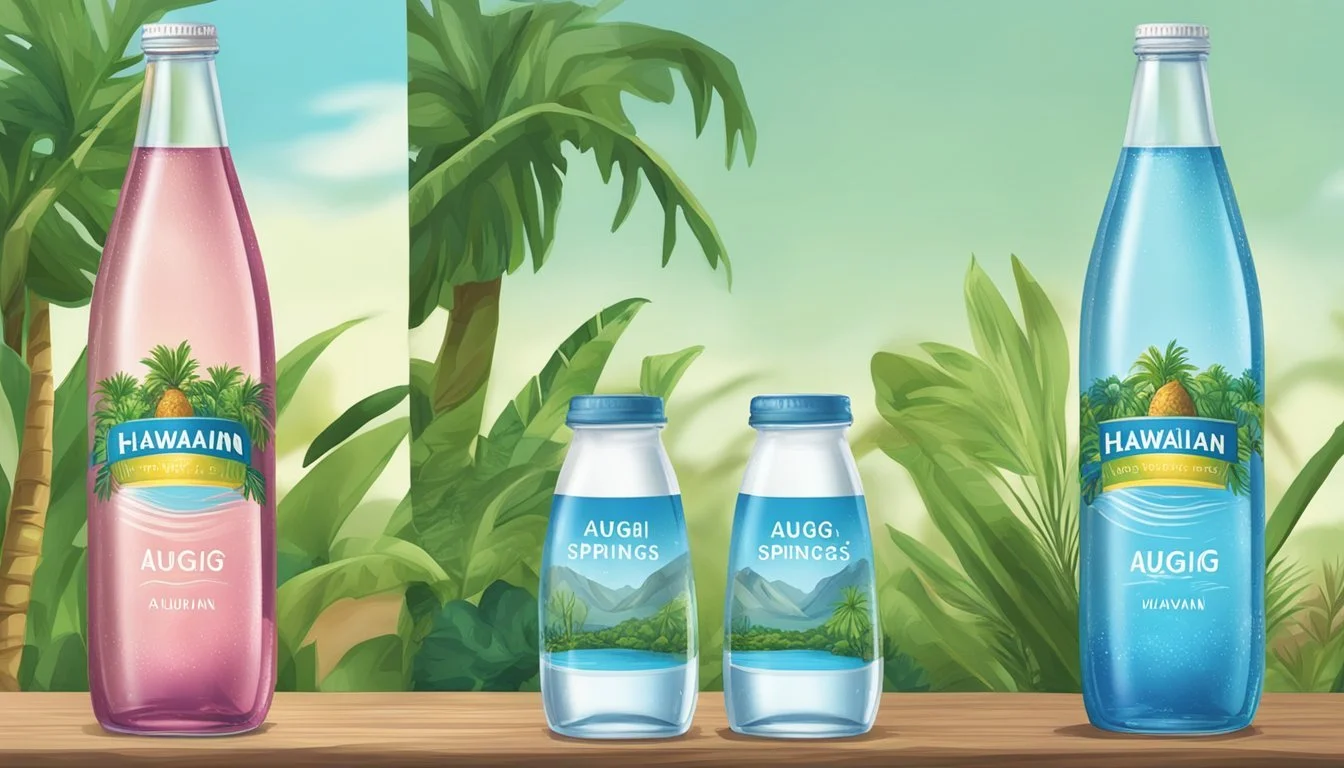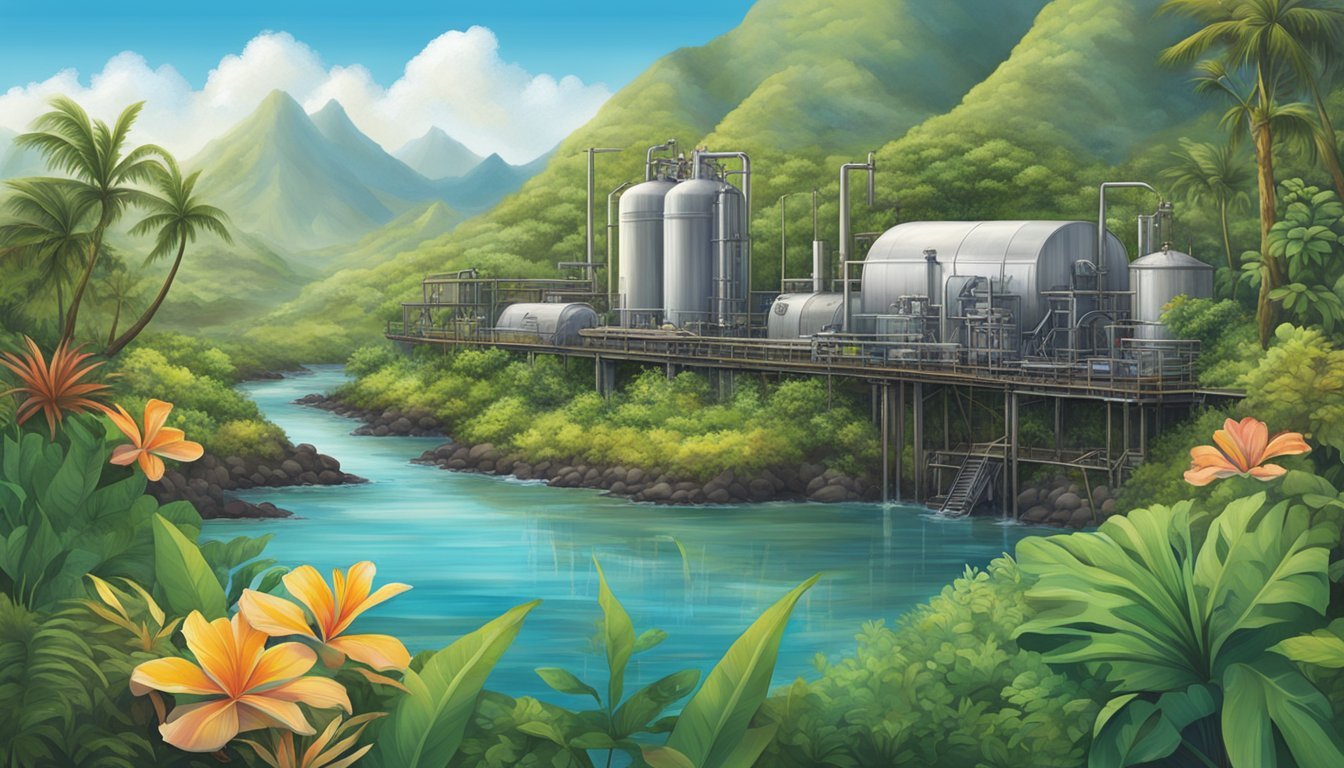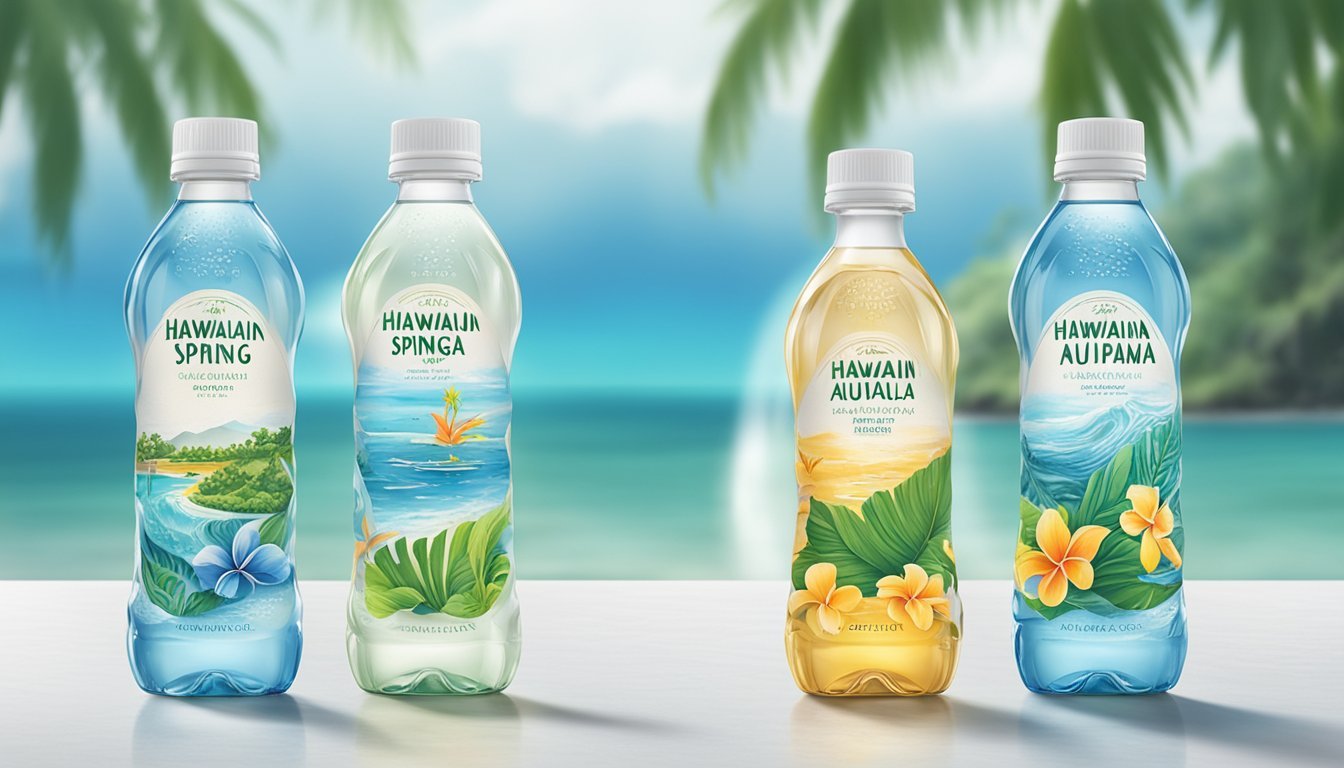Hawaiian Springs vs. Augi
Evaluating the Superior Bottled Water
When it comes to choosing the best bottled water, Hawaiian Springs and Augi are two popular options that often come up in the discussion. Both brands highlight their commitment to quality, yet they have distinct features that set them apart.
Hawaiian Springs, sourced from an artesian aquifer on the Big Island, promotes its naturally alkaline water, light taste, and mineral-rich profile. Augi, on the other hand, boasts of pure water with a crisp, clean taste, emphasizing its advanced purification process. For those prioritizing a naturally alkaline water experience, Hawaiian Springs stands out, while Augi appeals to those seeking intensely purified water.
Understanding the specific characteristics of each brand can guide water enthusiasts in making an informed decision tailored to their preferences. With Hawaiian Springs offering an unprocessed taste and rich mineral content and Augi providing highly purified, crystal-clear water, the choice ultimately lies in what you value more in your bottled water experience.
Understanding Bottled Water
Bottled water comes in various types, including spring water, mineral water, and purified water. Each type is sourced and treated differently, impacting the taste and quality.
Spring Water: Naturally filtered as it flows from underground aquifers to the surface. Examples include Mountain Valley and Hawaiian Springs, renowned for their clean taste.
Mineral Water: Contains electrolytes and minerals like calcium and magnesium. These elements occur naturally in the groundwater and contribute to a distinct flavor profile.
Purified Water: This water goes through several filtration processes to remove impurities. Brands like Pure Life offer highly purified water that appeals to those seeking a neutral taste.
The water source plays a crucial role in determining the bottled water's characteristics. Natural artesian aquifers produce water with a high pH and minerals, enhancing its taste.
Most bottled waters claim to be free of contaminants often found in tap water, which may contain chlorine or fluoride. The choice between bottled and tap water often comes down to personal preference and concerns over water purity.
When assessing bottled water quality, consider the source, mineral content, and added electrolytes. Consumers should look for labels indicating the origin and composition of the water.
Here is a quick comparison:
Type Source Characteristics Spring Water Natural springs/aquifers Naturally filtered, retains minerals Mineral Water Groundwater/aquifers Contains essential minerals Purified Water Various (usually tap water) Highly filtered, neutral taste
Understanding these differences can help consumers make informed decisions about their bottled water preferences.
Origin and Source Analysis
Hawaiian Springs and Augi are premium bottled water brands that source their water from naturally occurring springs, ensuring a crisp and pure taste. Each brand employs a meticulous bottling process to maintain the quality and essence of their unique water sources.
Natural Sources: From Spring to Bottle
Hawaiian Springs
Hawaiian Springs sources its water from the volcanic Big Island of Hawaii. The water originates as rainwater in the mountain valleys, filtering through layers of volcanic rock and limestone. This natural filtration system enriches the water with minerals and a naturally alkaline pH of 7.7+.
Augi
Augi, on the other hand, taps into a pristine artesian aquifer known for its purity. Located in a remote, sustainable area, this aquifer is protected from contaminants, maintaining a high mineral content and pH balance conducive to health.
Bottling Process: Ensuring Purity
Hawaiian Springs
The water from Hawaiian Springs is bottled directly at the source to preserve its freshness and mineral composition. The company uses eco-friendly, fully recyclable packaging to minimize environmental impact. Each step, from collection to bottling, adheres to strict quality standards, ensuring that consumers receive pure, unprocessed water.
Augi
Augi’s bottling process is similarly rigorous. The water undergoes multiple filtration stages, including carbon filtration and UV light treatment, before being bottled. This comprehensive purification process removes impurities while retaining essential minerals. The bottles are designed to sustain the water’s natural characteristics during storage and transportation.
Health and Hydration Factors
When evaluating Hawaiian Springs and Augi bottled waters, two essential aspects to consider are the mineral and electrolyte contents as well as their pH levels and alkalinity.
Mineral and Electrolyte Contents
Minerals and electrolytes play a significant role in maintaining hydration and overall health. Hawaiian Springs is known for its naturally occurring minerals like calcium and magnesium, which contribute to its smooth taste. These minerals are crucial for bone health and muscle function.
Augi, on the other hand, boasts a blend of added electrolytes, including potassium and sodium. These elements are specifically formulated to replenish what the body loses through sweat. This makes Augi a preferred choice for athletes and those with active lifestyles.
Mineral Hawaiian Springs Augi Calcium Natural Added Magnesium Natural Added Potassium Not Specified Added Sodium Not Specified Added
pH Levels and Alkalinity
The pH level of water influences its alkalinity and how it interacts with the body's pH balance. Hawaiian Springs water typically has a more neutral pH level, which is generally around 7. This neutral pH supports daily hydration needs and is less likely to affect the body's natural pH balance.
Augi water often emphasizes its alkaline properties, boasting a higher pH level, usually above 8. Alkaline water advocates argue that it can help neutralize acid in the bloodstream, potentially offering benefits such as improved metabolism and increased hydration efficiency.
Measurement Hawaiian Springs Augi pH Level ~7 (Neutral) >8 (Alkaline)
Hawaiian Springs provides the benefits of naturally occurring minerals without altering the body's pH significantly. Augi's higher pH and added electrolytes target those seeking enhanced hydration and specific health benefits related to alkalinity.
Taste Profile Comparison
The comparison between Hawaiian Springs and Augi highlights differences in their taste profiles and the elements influencing those tastes. This includes the composition of the aquifers where each water is sourced and insights from consumer taste tests.
The Role of Aquifer Composition
Aquifer composition significantly impacts the taste of bottled water. Hawaiian Springs sources its water from ancient, naturally-filtered volcanic aquifers in Hawaii. These aquifers are known for their high mineral content, which imparts a subtle sweetness and smooth finish to the water.
Augi, on the other hand, is sourced from deep, relatively young aquifers that lack volcanic filtration. This results in a much lighter and crisper taste. The lower mineral content in Augi’s water is preferred by consumers seeking a cleaner mouthfeel without any aftertaste.
The choice of aquifer thus directly affects the mineral composition and age of the water, shaping the distinct taste profiles of Hawaiian Springs and Augi.
Consumer Taste Test Insights
In taste tests, consumers often note the distinct mineral taste of Hawaiian Springs. This water's slightly sweet and smooth profile is seen favorably by those who enjoy richer, minerally flavors. It stands out for its "voluptuous" and "full-bodied" characteristics, reminiscent of the feedback given to premium bottled waters.
Conversely, Augi is praised for its purity and crispness. Testers frequently highlight its clean taste, describing it as refreshing and ideal for daily hydration without any lingering flavors. This attribute appeals particularly to those who prefer water that does not interfere with other tastes, such as when consumed with meals.
Taste tests clearly indicate that the preference for either water largely depends on individual taste preferences, with Hawaiian Springs favored by those who appreciate a richer profile and Augi by those who enjoy a clean, crisp drink.
Environmental and Sustainability Considerations
Both brands, Hawaiian Springs and Augi, position themselves with attention to environmental and sustainability aspects. They focus on the materials used in packaging and the ethics surrounding water extraction and production.
Bottles and Packaging Impact
Hawaiian Springs uses durable, fully recyclable PET bottles. These plastics are designed for multiple uses and aim to minimize waste. PET bottles are lightweight, which reduces transportation emissions, but they also contribute to plastic pollution if not properly recycled.
Augi, on the other hand, has invested in boxed water packaging. These cartons are primarily made from renewable resources like paperboard and are easier to recycle. Some versions even incorporate plant-based cap materials. By using less plastic, Augi reduces its packaging's environmental footprint.
There are also differences in the types of packaging used by each brand. Hawaiian Springs primarily sticks to PET bottles, while Augi often uses recyclable boxes and glass bottles. Glass bottles, although heavier and more energy-intensive to transport, do not leach chemicals and can be used indefinitely without degradation.
Extraction and Production Ethics
Hawaiian Springs boasts of sourcing its water from renewable aquifers on the Hawaiian Islands. The water is bottled at the source, which reduces the need for extensive treatment. This localized approach minimizes carbon emissions related to transportation and promotes sustainability.
Augi emphasizes ethical water sourcing practices. They ensure that water extraction does not compromise the surrounding environment or local communities' access to safe drinking water. Augi claims to adhere strictly to sustainable practices, regularly assessing the environmental impact.
Both brands tackle their sustainability goals by promoting transparency in their production processes. Hawaiian Springs focuses on reducing its carbon footprint through localized bottling. Augi prioritizes minimizing environmental disruption through conscientious water sourcing.
By addressing these aspects, both Hawaiian Springs and Augi demonstrate their commitment to protecting the planet while offering high-quality drinking water.
Comparing Brands and Alternatives
Hawaiian Springs and Augi offer unique features in bottled water, but it's essential to compare them with other market alternatives and specialty waters to understand their standing comprehensively.
Market Alternatives: A Broad View
Several bottled water brands dominate the market, each with distinct qualities. Fiji Water is known for its purity and silica content, giving it a smooth taste. Essentia offers ionized hydration, appealing to health-conscious consumers. Dasani and Aquafina are widely available but often criticized for their taste and source, which is essentially municipal tap water.
Arrowhead and Poland Spring are trusted for their spring water sources. Lifewtr and Core Hydration focus on balanced pH levels and added electrolytes. Evian and Voss offer high-end choices with unique tastes due to their specific geological sources.
Other notable brands include Crystal Geyser, known for affordability, and Zephyrhills with its distinct regional flavor profile. Mountain Valley Spring Water has garnered attention for its rich mineral content and environmental commitments, with waters sourced from Arkansas.
Specialty Waters in Focus
Specialty waters provide different experiences compared to standard bottled water. Icelandic Glacial emphasizes its glacial origins, resulting in a naturally alkaline pH. Acqua Panna from Tuscany delivers a smooth, velvety texture, favored in gourmet circles. Flow boasts eco-friendly packaging and a naturally alkaline pH.
Waiakea offers volcanic water with minerals like silica and electrolytes, while Castle Rock promotes its water as organic and sustainably bottled. Antipodes from New Zealand is noted for its exceptionally pure taste. Penta and Eternal Water appeal for their purity processes and natural alkaline states.
San Pellegrino and Ethos Water stand out for their mineral content and social good commitments, respectively. All these alternatives provide diverse options, each catering to specific preferences, from taste and mineral content to environmental impact and origin.
By comparing the unique characteristics of these alternatives, consumers can make informed decisions best suited to their needs and values.
Quality and Safety Standards
Both Hawaiian Springs and Augi must adhere to strict quality and safety standards to ensure their bottled water is safe for consumers. They aim to comply with both EPA regulations and international guidelines while addressing contaminants and impurities through advanced filtration and disinfection methods.
Meeting EPA and International Guidelines
The Environmental Protection Agency (EPA) sets stringent regulations for bottled water quality. These regulations include limits on contaminants such as lead, mercury, and chlorine. Both Hawaiian Springs and Augi conduct regular testing to meet these standards.
Additionally, they aim to comply with international guidelines to ensure their products are recognized globally as safe drinking water. Augi uses reverse osmosis and deionization processes to remove potential contaminants, while Hawaiian Springs employs filtration and distillation methods.
Identifying Contaminants and Impurities
Hawaiian Springs and Augi both conduct thorough screenings for contaminants and impurities such as lead, mercury, and chlorine. Hawaiian Springs predominantly focuses on filtering natural spring water, ensuring minimal human impact. In contrast, Augi emphasizes advanced disinfection methods, including reverse osmosis and deionization, to purify its water.
Advanced techniques like distillation and various filtration methods are utilized by both brands to achieve high water quality. Each company provides transparent reports on the levels of different substances in their water, helping consumers make informed decisions about their drinking water.
Innovation in Water Filtration
Water filtration has witnessed significant advancements, ensuring cleaner and safer drinking water. One of the notable innovations is Hydro-7 technology. This advanced system claims to remove impurities at a molecular level, providing high-quality water.
Reverse osmosis is another widely recognized technique. It works by forcing water through a semi-permeable membrane, effectively removing contaminants. This method is known for its efficiency in eliminating harmful substances such as lead, chlorine, and bacteria.
Filtration systems have also become more sustainable. Many companies now focus on reducing waste and energy consumption. They use eco-friendly materials and offer reusable filters to minimize environmental impact.
Innovative designs in water filtration continue to evolve. Some systems incorporate smart technology, allowing users to monitor water quality and filter life using mobile apps. This ensures timely replacements and optimal performance.
To summarize key points:
Hydro-7: Removes impurities at a molecular level
Reverse osmosis: Effective in eliminating harmful substances
Sustainable designs: Focus on reducing waste and energy consumption
Smart technology: Monitors water quality and filter life
These advancements in water filtration demonstrate the industry's commitment to providing better and more sustainable solutions for clean drinking water.
More About Hawaiian Springs
Acqua Pana vs Hawaiian Springs: Which Bottled Water is Better?
Aqua Carpatica vs Hawaiian Springs: Which Bottled Water is Better?
Aquafina vs Hawaiian Springs: Which Bottled Water is Better?
Arrowhead vs Hawaiian Springs: Which Bottled Water is Better?
Boxed Water vs Hawaiian Springs: Which Bottled Water is Better?
Castle Rock vs Hawaiian Springs: Which Bottled Water is Better?
Core Hydration vs Hawaiian Springs: Which Bottled Water is Better?
Deer Park vs Hawaiian Springs: Which Bottled Water is Better?
Essentia vs Hawaiian Springs: Which Bottled Water is Better?
Hawaiian Springs vs 1907water: Which Bottled Water is Better?
Hawaiian Springs vs 7-Select: Which Bottled Water is Better?
Hawaiian Springs vs Alkaline88: Which Bottled Water is Better?
Hawaiian Springs vs Antipodes: Which Bottled Water is Better?
Hawaiian Springs vs Big Chill: Which Bottled Water is Better?
Hawaiian Springs vs BodyArmor: Which Bottled Water is Better?
Hawaiian Springs vs Cascade Mountain: Which Bottled Water is Better?
Hawaiian Springs vs CBD Living: Which Bottled Water is Better?
Hawaiian Springs vs Crystal Geyser: Which Bottled Water is Better?
Hawaiian Springs vs Crystal Lake: Which Bottled Water is Better?
Hawaiian Springs vs Essence pH10: Which Bottled Water is Better?
Hawaiian Springs vs Hawaii Volcanic: Which Bottled Water is Better?
Hawaiian Springs vs Kirkland Signature: Which Bottled Water is Better?
Hawaiian Springs vs Liquid Death: Which Bottled Water is Better?
Hawaiian Springs vs Mananalu: Which Bottled Water is Better?
Hawaiian Springs vs Open Water: Which Bottled Water is Better?
Hawaiian Springs vs Proud Source: Which Bottled Water is Better?
Hawaiian Springs vs Pure Life: Which Bottled Water is Better?
Hawaiian Springs vs Purely Sedona: Which Bottled Water is Better?
Hawaiian Springs vs Refreshe: Which Bottled Water is Better?
Hawaiian Springs vs Richard's Rainwater: Which Bottled Water is Better?
Hawaiian Springs vs Simple Truth: Which Bottled Water is Better?
Hawaiian Springs vs Solan de Cabras: Which Bottled Water is Better?
Hawaiian Springs vs Talking Rain AQA: Which Bottled Water is Better?
Hawaiian Springs vs The Well: Which Bottled Water is Better?
Hawaiian Springs vs Tru Alka: Which Bottled Water is Better?
Hawaiian Springs vs Weird Water: Which Bottled Water is Better?
Hawaiian Springs vs Whole Foods 365: Which Bottled Water is Better?
Hawaiian Springs vs Whole Foods Italian Still Mineral water: Which Bottled Water is Better?
Ice Mountain vs Hawaiian Springs: Which Bottled Water is Better?
Icelandic Glacial vs Hawaiian Springs: Which Bottled Water is Better?
Just Water vs Hawaiian Springs: Which Bottled Water is Better?
Mountain Valley Spring Water vs Hawaiian Springs: Which Bottled Water is Better?
Nestle Pure Life vs Hawaiian Springs: Which Bottled Water is Better?
Poland Spring vs Hawaiian Springs: Which Bottled Water is Better?
San Pellegrino vs Hawaiian Springs: Which Bottled Water is Better?
Smartwater vs Hawaiian Springs: Which Bottled Water is Better?
Topo Chico vs Hawaiian Springs: Which Bottled Water is Better?
Zephyrhills vs Hawaiian Springs: Which Bottled Water is Better?






